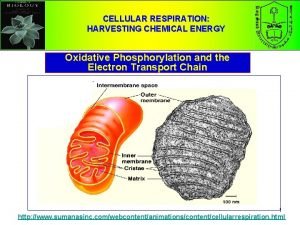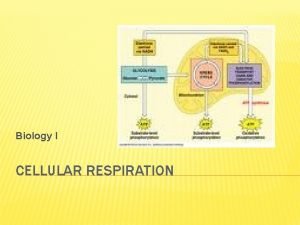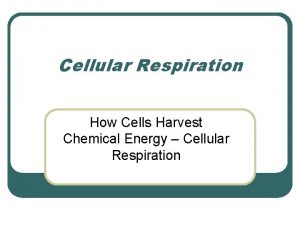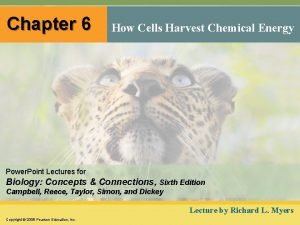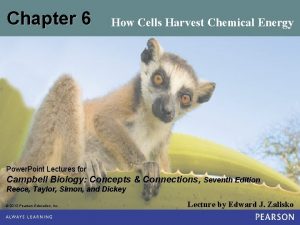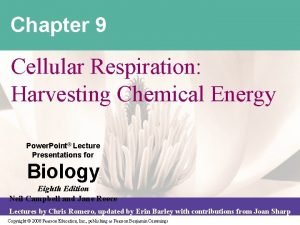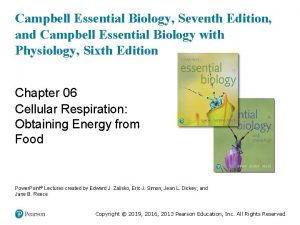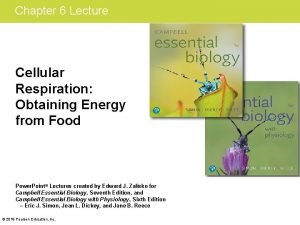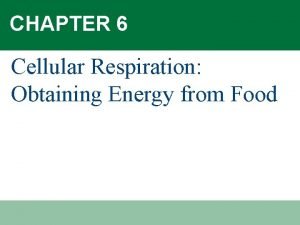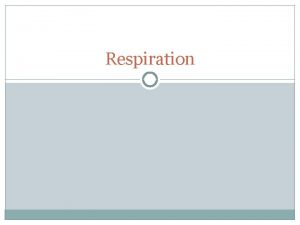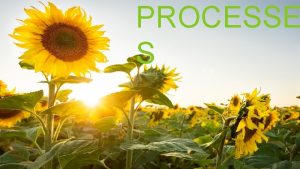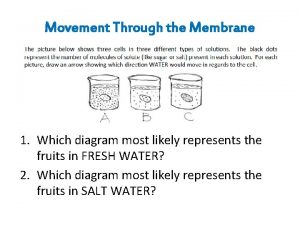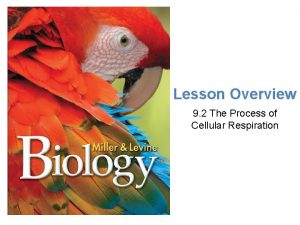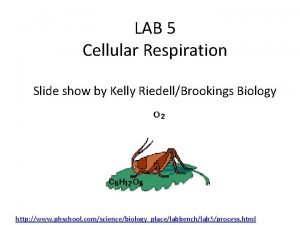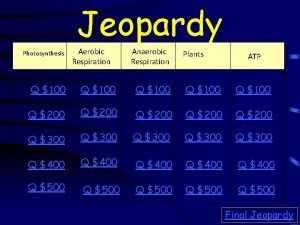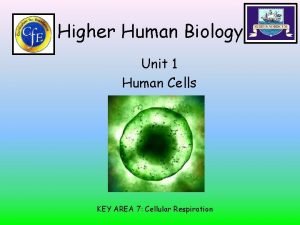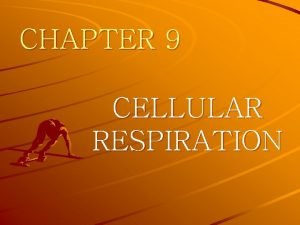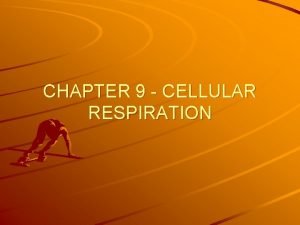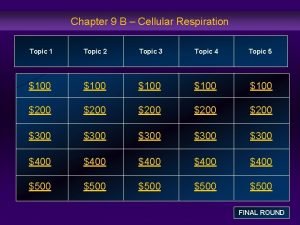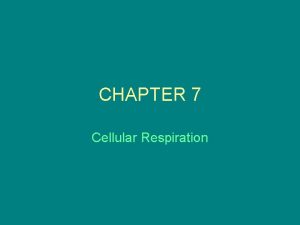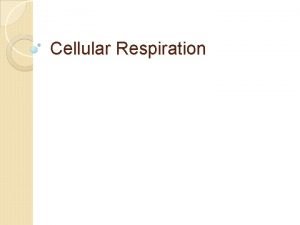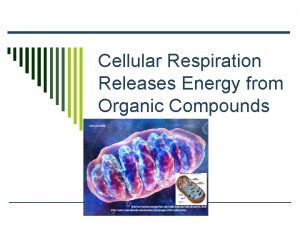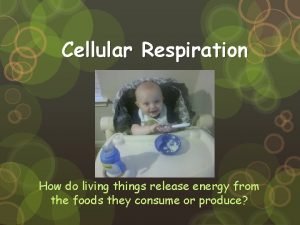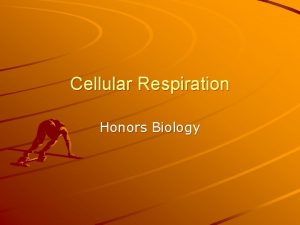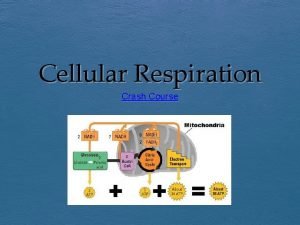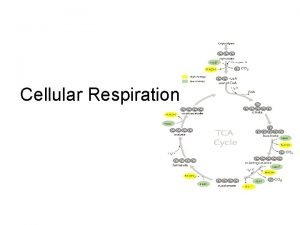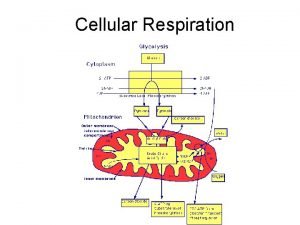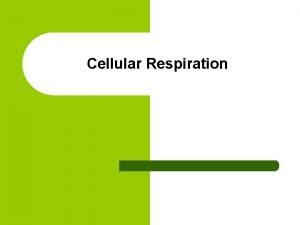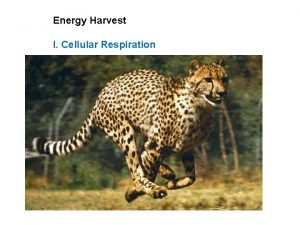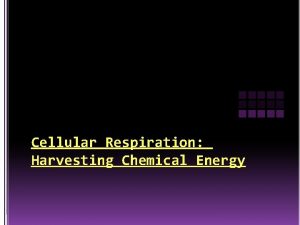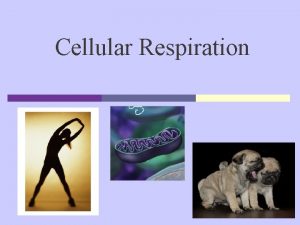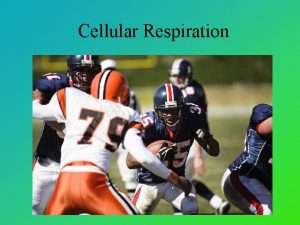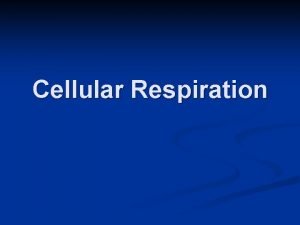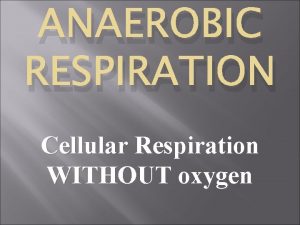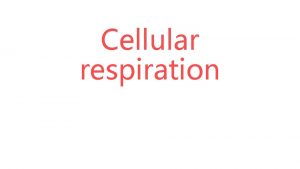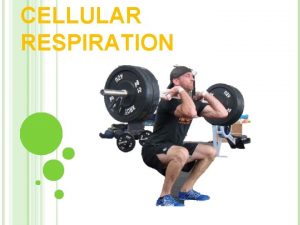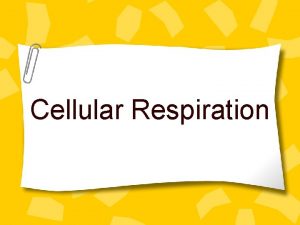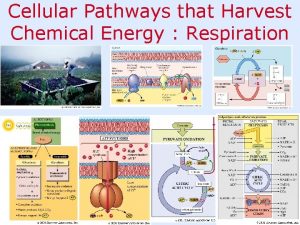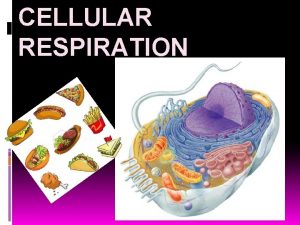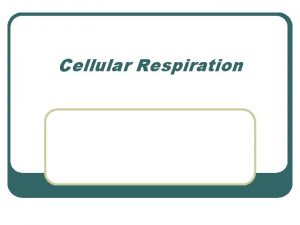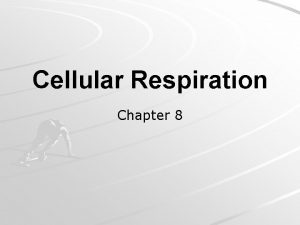Energy Harvest I Cellular Respiration Chemical Potential Energy













































- Slides: 45

Energy Harvest I. Cellular Respiration

Chemical Potential Energy Digestion and cellular respiration ENERGY FOR: Building stuff (making proteins, mostly) “ENTROPY” WORK (moving, generating heat, etc. )

+ Energy Coupled Reaction + Energy is tricky!! If it is not trapped in chemical bonds or spent as mechanical energy, it dissipates to environment as heat. In fact, every time energy is transformed, a little is lost as heat (second law of thermo). So, the energy released by the breaking of “food” must be trapped in new bonds of an ‘energy transport molecule’

+ Energy Coupled Reaction ATP ADP + Coupled Reaction + Energy

I. Cellular Respiration Overview:

MONOMERS and WASTE MATTER and ENERGY in FOOD DIGESTION AND CELLULAR RESPIRATION ADP + P ATP

I. Cellular Respiration Overview: Focus on core process… Glucose metabolism 1. GLYCOLYSIS - all cells ( bacteria, trees, people) do this in their cytoplasm.

III. Cellular Respiration Overview: 1. Glycolysis: - All cells do this! (very primitive pathway) - Occurs in the cytoplasm of all cells - Occurs in presence OR absence of oxygen gas. Glucose C 6 H 12 O 6 2 pyruvate 2 C 3

III. Cellular Respiration Overview: 1. Glycolysis: - Energy in 2 ATP is used to ‘activate’/start reaction 2 ATP Glucose C 6 H 12 O 6 2 ADP + P 2 pyruvate 2 C 3

III. Cellular Respiration Overview: 1. Glycolysis: - Energy in 2 ATP is used to ‘activate’/start reaction - breaking the C-C bond in glucose releases e- /Energy - electrons accepted by NAD- +H+ NADH 2 ATP 2 ADP + P NADH Glucose C 6 H 12 O 6 2 pyruvate 2 C 3 4 ADP + P 4 ATP

III. Cellular Respiration Overview: GLYCOLYSIS PYRUVATE METABOLISM Oxygen Absent? No more bonds broken SOME ATP Oxygen Present? All C-C bonds in pyruvates broken MORE ATP

III. Cellular Respiration Overview: 1. Glycolysis 2. Anaerobic Respiration 3. Aerobic Respiration Occurs in: Aerobic bacteria Aerobic Archaea All Eukaryotes (in the mitochondria descended from aerobic bacteria!) GLYCOLYSIS OCCURS IN THE CYTOPLASM. THAT’S WHERE THE PYRUVATES ARE PRODUCED.

III. Cellular Respiration Overview: 1. Glycolysis 2. Anaerobic Respiration C 3 C 2 + CO 2 Pyruvate NAD “Gateway Step” In Eukaryotes NADH

Aerobic Respiration Citric Acid (“Krebs”) Cycle C 2 NAD (oxaloacetate) NADH C 6 C 4 C 5 + CO 2 NADH FAD C 4 + CO 2 FADH 2 ADP + P ATP NADH

2. Aerobic Respiration Electron Transport Chain across a membrane to convert energy harvested in NADH into bonds in ATP. OUTER Intermembrane (periplasmic) space H+ H+ H+ e. INNER e. NADH NAD + H+ e- ADP + P ATP O FADH FAD + 2 H+ 2 O-- 2 H 2 O 2 H+ Electrons transferred, H+ ions pulled across membrane, and flood back across creating ATP. But O 2 is the final electron acceptor, making WATER!! MORE electrons transferred, stronger ‘pull’ exerted by oxygen, more ATP made.

III. Cellular Respiration Overview: 1. Glycolysis 2. Anaerobic Respiration 3. Aerobic Respiration d - Electron Transport Chain: convert energy in NADH, FADH to ATP - OXYGEN is just an electron ACCEPTOR - WATER is produced as a metabolic waste - All carbons in glucose have been separated into CO 2 molecules - Energy has been harvested and stored in bonds in ATP

FOOD ATP ANABOLISM CO 2, water, and waste ADP + P WORK

Phosphorylation of myosin causes it to toggle and bond to actin; release of phosphate causes it to return to low energy state and pull actin…contraction.

ENERGY HARVEST I. II. Cellular Respiration Photosynthesis

Overview: A. Step One: Transferring radiant energy to chemical energy Energy of photon e. Transferred to an electron e-

Overview: A. Step Two: storing that chemical energy in the bonds of molecules e. ATP e- ADP +P C 6 (glucose) 6 CO 2 Light Dependent Light Independent Reaction

A. Step 1: The Light Dependent Reaction: 1. Primitive Systems a. Cyclic phosphorylation e- Used by photoheterotrophs: Purple non-sulphur bacteria, green non-sulphur bacteria, and heliobacteria PS I “photosystems” are complexes of chlorophyll molecules containing Mg, nested in the inner membrane of bacteria and chloroplasts.

A. Step 1: The Light Dependent Reaction: 1. Primitive Systems a. Cyclic phosphorylation e- acceptor e- PS I “photosystems” are complexes of chlorophyll molecules containing Mg, nested in the inner membrane of bacteria and chloroplasts.

A. Step 1: The Light Dependent Reaction: 1. Primitive Systems e- acceptor a. Cyclic phosphorylation e- e. The electron is transferred to an electron transport chain PS I The electron transport chain is nested in the inner membrane, as well; like in mitochondria….

A. Step 1: The Light Dependent Reaction: 1. Primitive Systems e- acceptor a. Cyclic phosphorylation e. ATP e. The electron is passed down the chain, H+ are pumped out, they flood back in and ATP is made. ADP+P PS I The electron transport chain is nested in the inner membrane, as well; like in mitochondria… and chemiosmosis occurs.

A. Step 1: The Light Dependent Reaction: 1. Primitive Systems a. Cyclic phosphorylation b. Sulpher bacteria Purple and green sulphur bacteria e- acceptor e. ATP e- An electron is excited by sunlight, and the energy is used to make ATP. The electron is returned to the photosystem…. CYCLIC PHOSPHORYLATION…. . BUT something else can happen… ADP+P PS I

A. Step 1: The Light Dependent Reaction: 1. Primitive Systems a. Cyclic phosphorylation b. Sulpher bacteria e- acceptor e. NADPH ATP e- ADP+P PS I The electron can be passed to NADP, reducing NADP to NADP- (+H+)

A. Step 1: The Light Dependent Reaction: 1. Primitive Systems a. Cyclic phosphorylation b. Sulpher bacteria e- acceptor e. NADP IF this happens, the electron is NOT recycled back to PSI. For the process to continue, an electron must be stripped from another molecule and transferred to the PS to be excited by sunlight… NADPH ATP e- ADP+P PS I The electron can be passed to NADP, reducing NADP to NADP- (+H+)

A. Step 1: The Light Dependent Reaction: 1. Primitive Systems a. Cyclic phosphorylation b. Sulpher bacteria e- acceptor e. NADP IF this happens, the electron is NOT recycled back to PSI. For the process to continue, an electron must be stripped from another molecule and transferred to the PS to be exited by sunlight… ATP e- ADP+P PS I H 2 S 2 e + 2 H+ + S The Photosystem is more electronegative than H 2 S, and can strip electrons from this molecule – releasing sulphur gas…. NADPH

A. Step 1: The Light Dependent Reaction: 1. Primitive Systems a. Cyclic phosphorylation b. Sulpher bacteria So, through these reactions, both ATP and NADPH are produced; sulphur gas is released as a waste product. e. These organisms are limited to living in an environment with H 2 S!!! (Sulphur springs). e- acceptor e. NADP ATP ADP+P PS I H 2 S 2 e + 2 H+ + S NADPH

A. Step 1: The Light Dependent Reaction: 1. Primitive Systems a. Cyclic phosphorylation b. Sulpher bacteria So, through these reactions, both ATP and NADPH are produced; sulphur gas is released as a waste product. e. These organisms are limited to living in an environment with H 2 S!!! (Sulphur springs). If photosynthesis could evolve to strip electrons from a more abundant electron donor, life could expand from these limited habitats… hmmm…. H 2 S…. e- acceptor e. NADP ATP ADP+P PS I H 2 S 2 e + 2 H+ + S NADPH


A. Step 1: The Light Dependent Reaction: 1. Primitive Systems 2. Advanced System e- acceptor Cyanobacteria, algae, plants PS II RIGHT! H 2 O!!! But water holds electrons more strongly than H 2 S; this process didn’t evolve until a PS evolved that could strip electrons from water… PSII.

A. Step 1: The Light Dependent Reaction: 1. Primitive Systems 2. Advanced System e- acceptor ee- PS II Photons excite electrons in both photosystems…

A. Step 1: The Light Dependent Reaction: 1. Primitive Systems 2. Advanced System e- acceptor ee- ATP ADP+P PS II The electron from PSII is passed down the ETC, making ATP, to PSI

A. Step 1: The Light Dependent Reaction: 1. Primitive Systems 2. Advanced System e- acceptor e. ATP ADP+P e- PS II The electron from PSI is passed to NADP to make NADPH

A. Step 1: The Light Dependent Reaction: 1. Primitive Systems 2. Advanced System e- acceptor e- NADPH ATP ADP+P e- PS II The e- from PSII has “filled the hole” vacated by the electron lost from PSI.

A. Step 1: The Light Dependent Reaction: 1. Primitive Systems 2. Advanced System e- acceptor e- NADPH ATP ADP+P e- PS II 2 H 2 O 4 e + 4 H+ + 2 O Water is split to harvest electrons; oxygen gas is released as a waste product. (O 2)

Those were the light dependent reactions; reactions in which photosynthetic organisms transform radiant energy into chemical bond energy in ATP (and NADPH). e. ATP e- ADP +P Light Dependent Reaction C 6 (glucose) 6 CO 2 Light Independent Reaction

A. Step 1: The Light Dependent Reaction: B: Step 2: The Light-Independent Reaction: e. ATP e. Light Dependent Reaction ADP +P C 6 (glucose) 6 CO 2 Light Independent Reaction

CO 2 B. The Light Independent Reaction C 6 C 5 Ru. BP 2 C 3 (PGA) A molecule of CO 2 binds to Ribulose biphosphate, making a 6 -carbon molecule. This molecule is unstable, and splits into 2 3 -carbon molecules of phosphoglycerate (PGA)

B. The Light Independent Reaction 6 CO 2 6 C 6 6 C 5 Ru. BP 12 C 3 (PGA) Now, it is easier to understand these reactions if we watch the simultaneous reactions involving 6 CO 2 molecules

B. The Light Independent Reaction 6 CO 2 6 C 6 6 C 5 Ru. BP 12 C 3 ATP 10 C 3 2 of the 12 PGA are used to make glucose, using energy from ATP and the reduction potential of NADPH… essentially, the H is transferred to the PGA, making carbohydrate from carbon dioxide. 2 C 3 NADPH NADP ADP+P C 6 (Glucose)

B. The Light Independent Reaction 6 CO 2 6 C 6 6 C 5 Ru. BP 12 C 3 ATP ADP+P More energy is used to rearrange the 10 C 3 molecules (30 carbons) into 6 C 5 molecules (30 carbons); regenerating the 6 Ru. BP. 10 C 3 2 C 3 NADPH NADP ADP+P C 6 (Glucose)

Review
 Cellular respiration harvesting chemical energy
Cellular respiration harvesting chemical energy Chapter 9 cellular respiration harvesting chemical energy
Chapter 9 cellular respiration harvesting chemical energy Chapter 9: cellular respiration: harvesting chemical energy
Chapter 9: cellular respiration: harvesting chemical energy Cellular respiration harvesting chemical energy
Cellular respiration harvesting chemical energy Chemical equation for cellular respiration
Chemical equation for cellular respiration What's the equation for cellular respiration
What's the equation for cellular respiration What is the word equation for cellular respiration
What is the word equation for cellular respiration How cells harvest chemical energy
How cells harvest chemical energy Chapter 6 how cells harvest chemical energy
Chapter 6 how cells harvest chemical energy Chapter 6 how cells harvest chemical energy
Chapter 6 how cells harvest chemical energy Energy flow in cellular respiration
Energy flow in cellular respiration Chemical cycling in an ecosystem
Chemical cycling in an ecosystem Cellular respiration obtaining energy from food
Cellular respiration obtaining energy from food Cellular respiration obtaining energy from food
Cellular respiration obtaining energy from food Elastic potential energy examples
Elastic potential energy examples Cellular respiration redox
Cellular respiration redox What is the correct equation for cellular respiration?
What is the correct equation for cellular respiration? Cellular respiration steps
Cellular respiration steps Types of respiration
Types of respiration Anaerobic respiration diagram
Anaerobic respiration diagram Why is cellular respiration important
Why is cellular respiration important Complimentary processes
Complimentary processes Amloplast
Amloplast Equation for cellular respiration
Equation for cellular respiration Photosynthesis recipe card
Photosynthesis recipe card What happens during glycolysis
What happens during glycolysis Overview of cellular respiration
Overview of cellular respiration Respiration overview
Respiration overview Overview of cellular respiration
Overview of cellular respiration Total atp produced in cellular respiration
Total atp produced in cellular respiration Lab bench cellular respiration
Lab bench cellular respiration What is the word equation for cellular respiration
What is the word equation for cellular respiration Higher human biology cellular respiration
Higher human biology cellular respiration What is the correct equation for cellular respiration?
What is the correct equation for cellular respiration? Cellular respiration releases
Cellular respiration releases Starting materials for cellular respiration
Starting materials for cellular respiration Chapter 8 section 3: cellular respiration
Chapter 8 section 3: cellular respiration Redox reaction in cellular respiration
Redox reaction in cellular respiration Where in the cell does cellular respiration occur
Where in the cell does cellular respiration occur Role of cellular respiration
Role of cellular respiration Cellular respiration releases
Cellular respiration releases Cellular respiration redox
Cellular respiration redox Respiration crash course
Respiration crash course Cellular respiration
Cellular respiration Cellular respiration process diagram
Cellular respiration process diagram Overall reaction of cellular respiration
Overall reaction of cellular respiration



